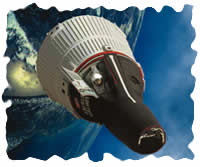
Dimdima
Online Children's Magazine from India

Dimdima
Online Children's Magazine from India

Gemini
Project Mercury had shown that manned space flights were possible but more experience in space travel was needed before American astronauts could embark on a journey to the moon.
Among other things it remained to be seen whether spacemen could step out of their spacecraft, in space. The Americans set out to find out the answer to this question and others through the Gemini series of flights.
The Gemini spacecraft looked like an enlarged version of Mercury but it was far more sophisticated. It could hold two astronauts who sat in ejector seats in a conical capsule, 2.3 m wide at its base. In case of an emergency during the launch, the crew could eject to safety. Behind the conical crew compartment was an equipment section that contained supplies of air, and fuel cells for generating electricity. It also housed the retro-rockets. This equipment section was discarded before re-entry to expose the heat shield at the base of the conical crew compartment. In all, the spacecraft weighed 3.6 tonnes and had a length of 5.6 metres.
It was launched by the powerful two-stage Titan rocket.
 The goal of the Gemini program included developing techniques of docking with other spacecraft, and subjecting men and machines to space flights lasting up to two weeks.
The goal of the Gemini program included developing techniques of docking with other spacecraft, and subjecting men and machines to space flights lasting up to two weeks.
The first manned Gemini launch was scheduled for March 1965 but the Soviet Union appeared to be determined to show that it was ahead in the space race. In October 1964 it launched its new spacecraft Voshkod.
Voshkod 1 carried three cosmonauts.
EXPLORE MORE...
Get Help or Give Help.
- Do you have a Science Question?
- Post it here and get the answer.
- Some questions posted by others are not yet answered.
- View those questions and answer them.
Dimdima is the Sanskrit word for ‘drumbeat’. In olden days, victory in battle was heralded by the beat of drums or any important news to be conveyed to the people used to be accompanied with drumbeats.
Bharatiya Vidya Bhavan
K. M Munshi Marg,
Chowpatty, Mumbai - 400 007
email : editor@dimdima.com
Bharatiya Vidya Bhavan
505, Sane Guruji Marg,
Tardeo, Mumbai - 400 034
email : promo@dimdima.com
Dimdima.com, the Children's Website of Bharatiya Vidya Bhavan launched in 2000 and came out with a Printed version of Dimdima Magazine in 2004. At present the Printed Version have more than 35,000 subscribers from India and Abroad.